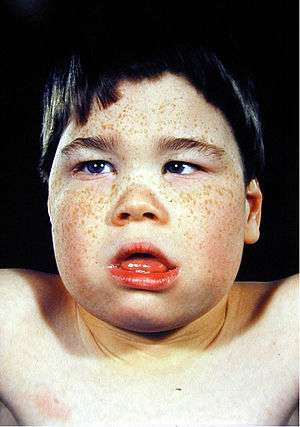Alpha-thalassemia mental retardation syndrome
| Alpha-thalassemia mental retardation syndrome | |
|---|---|
 | |
| Child of 8 yrs with the characteristic facial features of ATR-X syndrome. Note the upswept frontal hair line, hypertelorism, epicanthic folds, flat nasal bridge, small triangular upturned nose, tented upper lip, everted lower lip and hypotonic facies. |
Alpha-thalassemia mental retardation syndrome (ATRX), also called alpha-thalassemia X-linked mental retardation, nondeletion type or ATR-X syndrome,[1] is a condition caused by a mutated gene. Females with this mutated gene have no specific signs or features, but may demonstrate skewed X chromosome inactivation. Hemizygous males tend to be moderately intellectually disabled and have physical characteristics including coarse facial features, microcephaly (small head size), hypertelorism (widely spaced eyes), a depressed nasal bridge, a tented upper lip, and an everted lower lip.[2] Mild or moderate anemia, associated with alpha-thalassemia, is part of the condition.[3]
References
- ↑ Online Mendelian Inheritance in Man (OMIM) 301040
- ↑ Robert J. Gorlin; Meyer Michael Cohen; Raoul C. M. Hennekam (2001). Syndromes of the Head and Neck. Oxford University Press. p. 986. ISBN 0-19-511861-8.
- ↑ Stevenson, Roger E. (1993-01-01). Pagon, Roberta A.; Adam, Margaret P.; Ardinger, Holly H.; Wallace, Stephanie E.; Amemiya, Anne; Bean, Lora JH; Bird, Thomas D.; Dolan, Cynthia R.; Fong, Chin-To, eds. Alpha-Thalassemia X-Linked Intellectual Disability Syndrome. Seattle (WA): University of Washington, Seattle. PMID 20301622.
- ↑ Medina CF, Mazerolle C, Wang Y, et al. (March 2009). "Altered visual function and interneuron survival in Atrx knockout mice: inference for the human syndrome". Hum. Mol. Genet. 18 (5): 966–77. doi:10.1093/hmg/ddn424. PMID 19088125.
Further reading
External links
| Classification |
|---|
This article is issued from
Wikipedia.
The text is licensed under Creative Commons - Attribution - Sharealike.
Additional terms may apply for the media files.